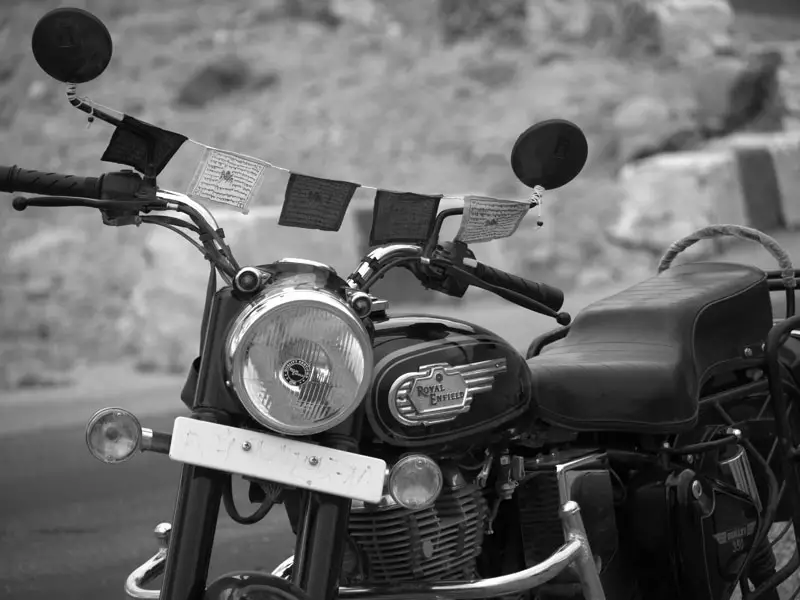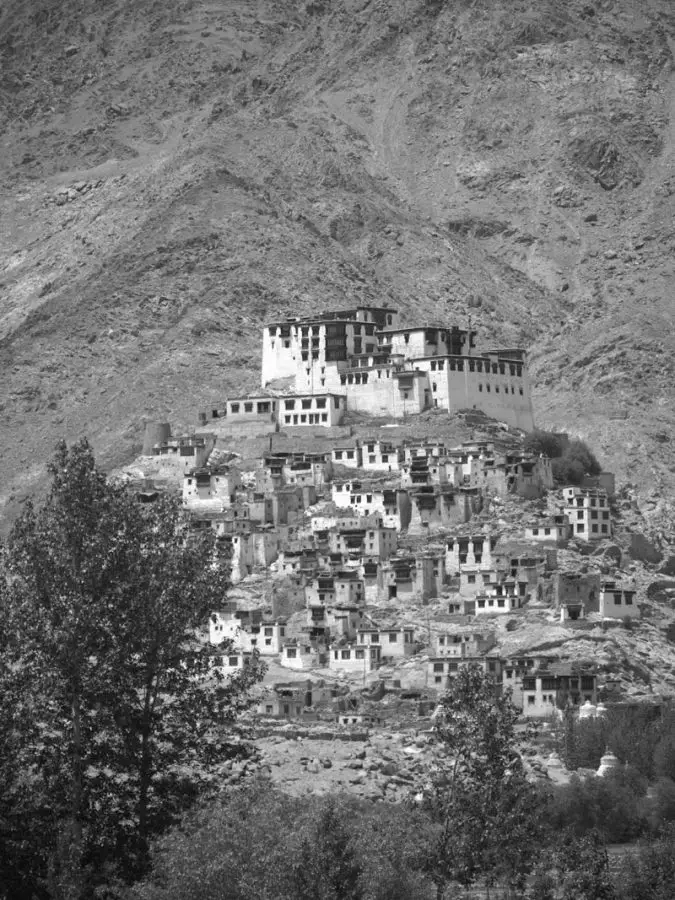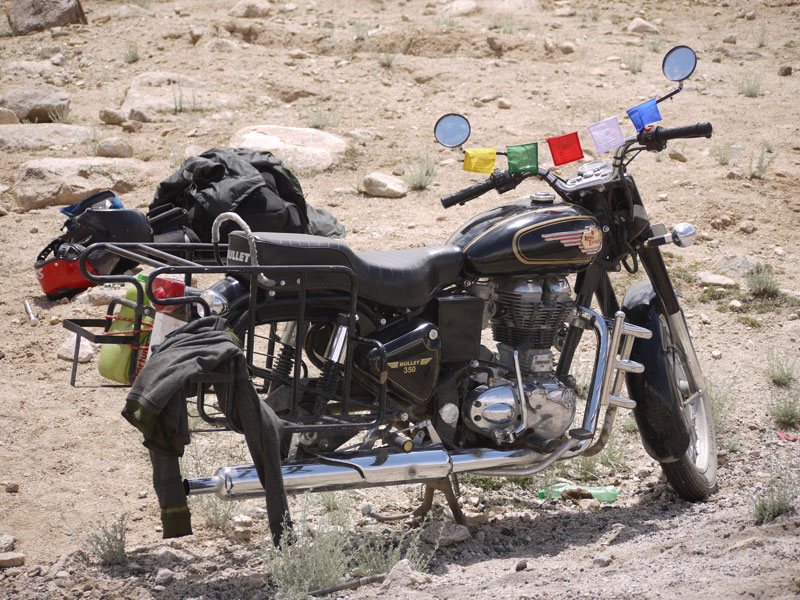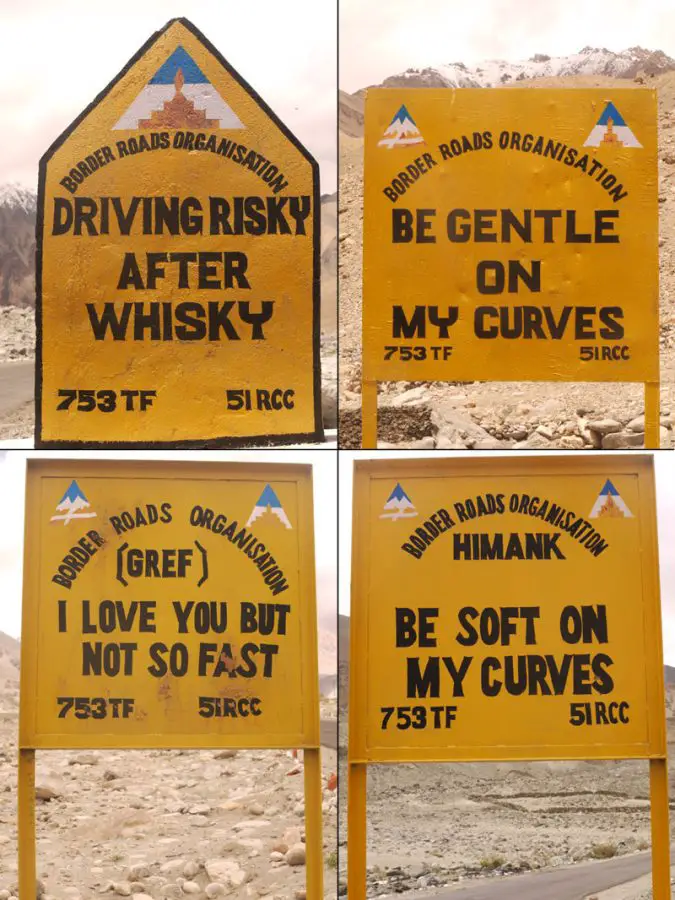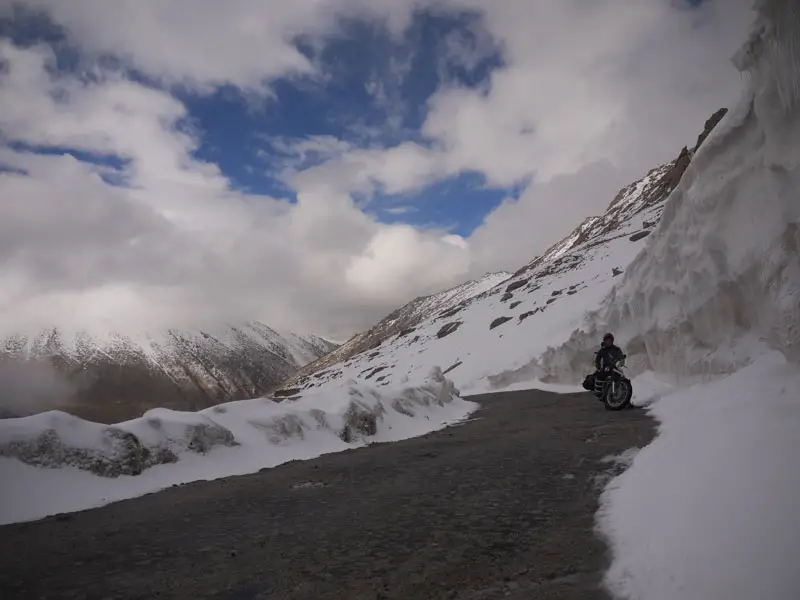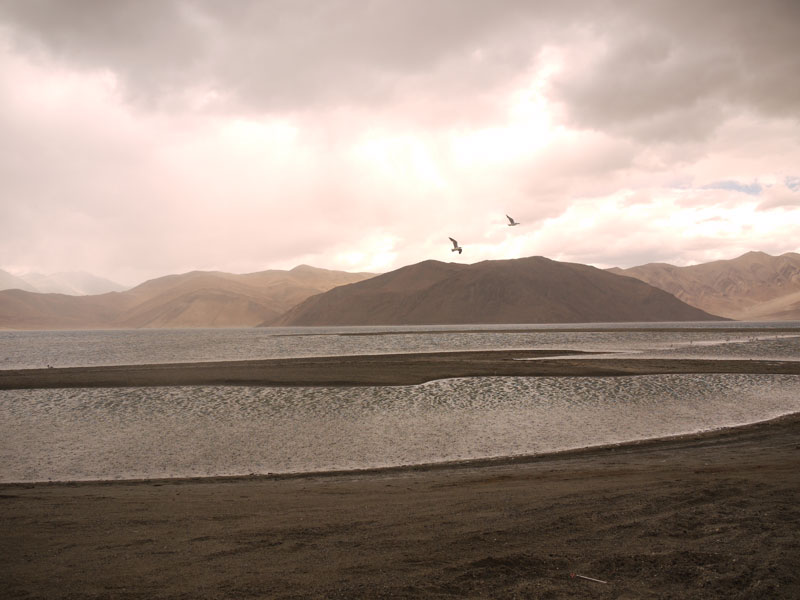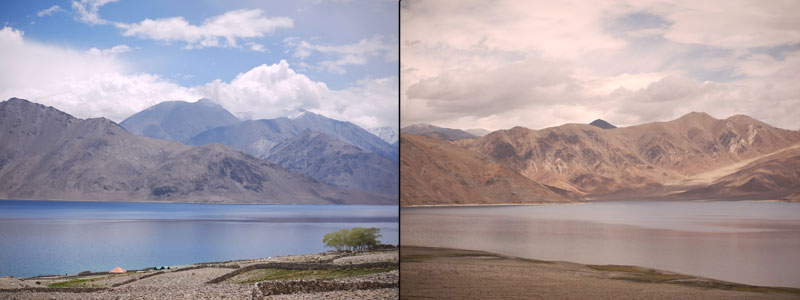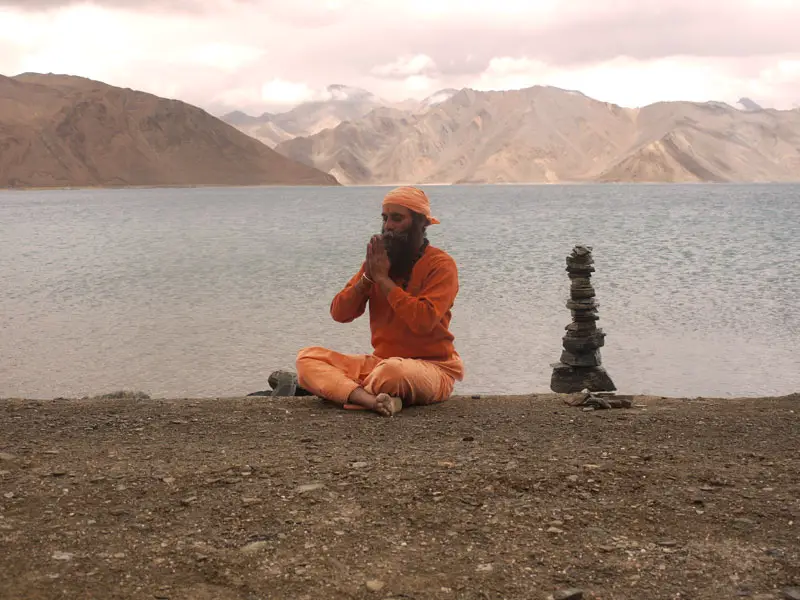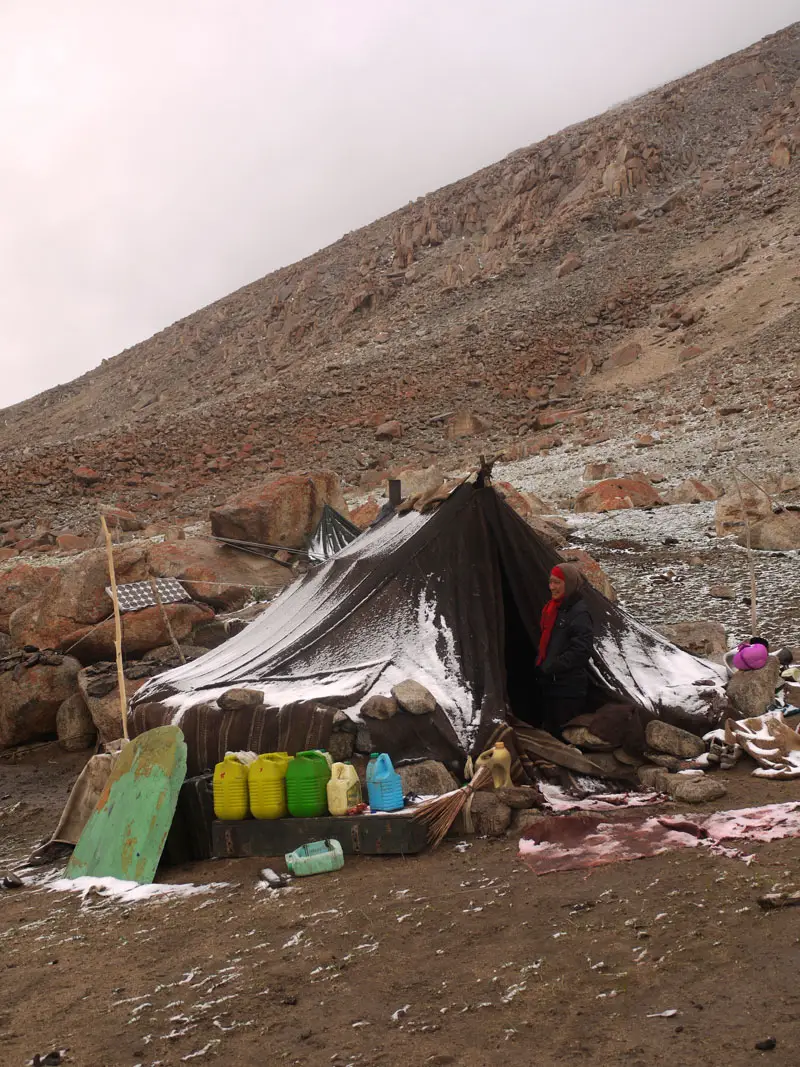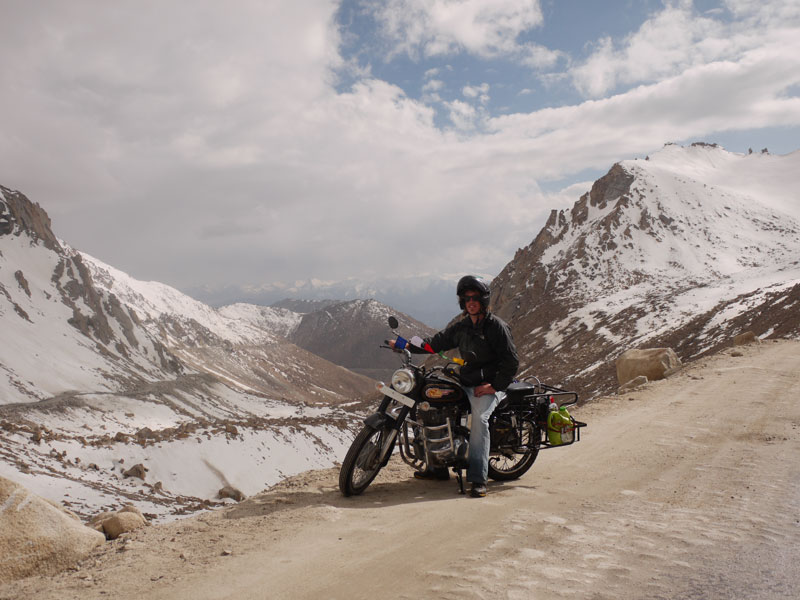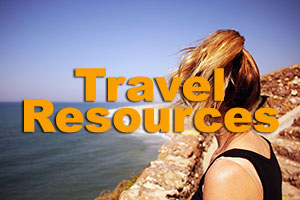In eastern Ladakh on the India/China border is an enormous lake called Pangong Tso. The six-hour drive to the lake takes you through remote settlements in huge valleys over the Chang La road pass at 5,289 meters, the third highest road pass in India and treats you to unbeatable scenery along the hair-raising journey. The route is littered with views of trickling streams, horse meadows, drifting sands, snow-capped peaks and glowing red rock faces. The contrast between the bright blue skies, reflective waters and dry desert mountains is a trip. Old Buddhist monasteries sit on rocky ridges high above the road around random corners and, together with the stunning scenery, make for a magical journey towards Pangong Tso. However, for us the beauty of Pangong Tso and the surrounding valleys is only half the story. I had a romantic notion when planning this trip to India to drive an old school Royal Enfield motorbike through the Indian Himalayas at some point on our travels and this was our opportunity to have a go. Not being big bike people we shopped around and found a suitable bike in excellent condition with a big rack on the back for luggage and spare fuel. Carrying extra fuel on this journey is vital because once you reach Karu, just 35km outside of Leh, there are no more petrol stations or mechanics until you return to Karu on your way back. You should really know what you are doing on these roads being so far from help but with hardly a clue between us we got ready to begin our journey. Tying Buddhist prayer flags to the front of the bike for good luck, we hoped for the best, kick started the heavy bike and headed east.
It was slow going in the beginning trying to get a feel for driving the big, heavy Royal Enfield Bullet but thankfully we made it out of the traffic in Leh without incident. The roads got much quieter as we passed the famous Thiksey Gompa and the 17th century Shey Gompa, we could finally pull back on the throttle on the smooth, open roads and see what driving a bike like this was all about. Flying along we reached Karu in no time and then disaster struck. Seven kilometers beyond Karu we heard a loud pop and the bike wasn’t driving in a straight line anymore, we looked down and sure enough the back wheel was as flat as a pancake. Around us was nothing but the huge Chemrey monastery and expansive mountain desert.
Luckily another couple, also headed to Pangong Tso, stopped to see what the problem was. They went looking for help but after exhausting the limited options it seemed like the only choice was to wheel the bike the seven kilometers back the road to Karu where the puncture could be repaired. We wished the couple luck and began wheeling the bike back towards Karu but it was slow going. Another biker pulled in, this time an Indian guy and with his help we managed to wave down a passing pickup and hitch a ride back to Karu, leaving the bike pulled in on the side of the road. The whole ordeal deayed us three hours. We tracked down a mechanic in Karu who agreed to come with us in a taxi back out to the bike. He then had to take the wheel off the bike, bring the wheel back to Karu in the taxi while we waited with the bike and then he returned forty five minutes later, just as we were losing hope, with the repaired wheel, refitted it to the bike and we were ready to go. Sincerely thanking the mechanic and the taxi driver we payed them, said goodbye and continued driving east towards China.
Road conditions were excellent all the way until the route began to climb up towards the Chang La. Every now and then we passed road safety signs erected by the Border Road Organisations (BRO). Whoever had commissioned these signs had a great sense of humour and had us in stitches as we passed signs that read things like “driving risky, after whisky”, “Be Mr. Late, Not a Late Mr.”, “Life is a journey, Finish it”, “This is a road, Not a runway” and our favourite “I love you but not so fast”. All of a sudden the road was unpaved, scattered with potholes and loose gravel and felt more like riding in a motocross event than cruising perfect mountain roads but we persevered.
Rattling along the road another problem faced us, there was a river running across the road which, on a motorbike, I thought would be impassable. Had we been in a jeep or a car I wouldn’t have hesitated to continue but bouncing across rocks under a foot of freezing cold mountain water made me think twice about it. Luckily, a few other motorcyclists were pulled in taking a break from the rough road and told us “you need a low gear, go 10km per hour and hold on tight, no problem”, just the encouragement we needed! Revving the bike we went for it but it didn’t go as smoothly as he had described. Not starting off fast enough was our major fault and halfway through the water the bike conked out and my left shoe was full of water and my jeans soaked halfway up to my knee and in the cold air it was no laughing matter! Our road side advisors came to the rescue helping to push the bike through the river, luckily it started up first time and a little red-faced we waved goodbye and drove away climbing towards the Chang La.
Reaching the Chang La road pass, we had to pass through another few road-crossing rivers, thankfully with much more success than the first time. Snow began to fall as we got closer to the top and icy snow was piled high on either side of the road. A quick stop for a hot chai to warm up from the cold mountain air and with it getting late we continued on to Pangong Tso. The road down the other side of the pass was equally bad and we bounced through another river but this time gravity was on our side and we made it through unscathed. Once through this obstacle the road again improved all the way to the lake. Our incident with the flat tyre had delayed us three hours and now unfortunately time was against us. Arriving at Pangong Tso lake it was pitch black and the headlight of the motorbike was getting lost in the darkness ahead. We followed the banks of the lake and came to an unsignposted fork in the road. In an eeny-meeney-miney-mo moment we chose the right hand fork and hoped for the best. There were supposed to be three towns further up the road but there were no lights in the distance. Just as we were losing faith, all of a sudden all the lights came on and after dealing with a puncture and driving six hours on dodgy roads we knew we were headed the right direction. We rolled into a homestay just as they were preparing dinner and met some really friendly Indians who we hung out with for the evening, all the while the drive back to Leh the following morning looming over us.
The next morning we woke to overcast skies but the lake looked amazing nonetheless. After a quick breakfast of roti and eggs we drove down to the edge of the lake to take some photos. The extraordinary thing about the lake and the mountains surrounding it was that they appeared to be changing colour. It was as if the landscape was alive with constantly morphing scenery. Staying there for hours or even days taking photos would have been too easy and when you add in the birds who flew around the sand spit without a care, it made for a tranquil yet ever-transitioning scene. Of course, while we were standing there it started to rain heavily and between getting carried away taking photos and hiding from the rain we were beginning the return leg of our journey again with time against us.
An unepxpected but very welcome interruption to our mornings plan occurred as we pulled in one last time to shoot the photogenic lake. A Baba (Hindu holy man) was walking down the road towards us bare foot in full length bright orange robes. His hair was long down his back and dreadlocked, he wore long wooden beads around his neck, had a long grey/black beard and carried only a small canvas satchel with a wooden flute inside. This man looked like an image straight off an India postcard and I had to stop him for a photo in front of the bright blue lake but the Baba had better ideas. Charismatic and certainly a bit of an eccentric, he gave us his camera and directed his own photo shoot! Shots in front of the lake, meditating and playing the flute were followed by a video of him playing the flute down by the lake. We took all the photos and footage for him, with his camera and our own. It was a truly surreal experience watching Bansai Baba sit cross-legged and play the flute on the banks of Pangong Tso with nobody around for miles and the only other sound, the gentle breeze floating across the lake. Baba Bansai gave us his business card for his ashram in Rishikesh and with promises to see him there we finally drove away from Pangong Tso and back west to Leh.
Confidence was up on yesterday and we flew along the comfortable roads stopping along the way to take photos of the incredible surroundings. Tangtse was the venue for our lunch stop and then it was time to motor on and get back to Leh in time to get our rental back to the shop. In keeping with yesterdays steady stream of bad luck it seemed like today wasn’t going to be much better. Leaving the lake behind us the sky quickly change from bright blue to grey and it started snowing. The snow got heavier and heavier and in a few minutes the road ahead was barely visible but with nowhere to pull in we had no choice but to continue.
Cleverly, I had forgotten to bring gloves and with the pass approaching and the snow getting heavier my hands were gone completely numb. It got to such a point that I could no longer use the clutch or the front brake without assisting my hands to where they needed to be. Thankfully a parachute cafe appeared on the right and we dismounted and ran inside to hold cups of tea to try to warm up. While inside the snow got heavier and heavier but the kind man running the make-shift cafe brought us into his wife and daughters tent behind where a fire was going strong. The tent was like a native American tee-pee and constructed from yak wool was 100% waterproof. The mother was making cheese in one corner, her hair arranged in two long pigtails which were tied together at the base of her back and even included some yak wool extensions, her daughter told us. These people were semi-nomadic, living in this tent in the middle of nowhere, completely self-sufficient for three months of the year. We were very lucky to have been invited inside the tent and have an opportunity to meet these kind people and see how they live. They had so little and had wanted to give us one of their pairs of yak wool socks to keep our hands warm on the bike but we had to decline their offer. It’s truly amazing how people can live in such make-shift conditions in remote areas like this and still be so welcoming, friendly and kind, it was inspiring.
The snow let up for now but as we continued to climb to Chang La it started again, stronger than ever. A pair of cotton socks was the best we could do to have some form of a barrier between fingers and cold and it helped but the weather still wasn’t playing ball. The road was visible a maximum of three meters ahead and with rough terrain beneath our tyres again we slowly and carefully made our way along the gravelly road. We reached the pass and were asked by some Indian tourists to join them on the roof of an army truck for a photo, with the soldier inside the cab! We obliged and then had to keep moving, albeit at a snail’s pace, down the other side of the pass. By now we were freezing cold but we kept thinking ‘once we get down from this height the weather will improve’. We made it out of the clouds and at least the visibility had improved. Now was a little taste of home, the rain started as we came out of the clouds and continued to pour as we drove back to Leh, our teeth gritted in sheer determination to make it despite the weather. We arrived back in Leh drowned to the bone, freezing cold and just in time to see the shop shutter being pulled down. We were more than two hours late back with the rental but thankfully the guys in the shop were extremely understanding and we handed back the keys thankful both we and the bike had made it back without injury.
It had been a roller-coaster of a journey with ups and downs like no other we had experienced. The flat tyre, arriving in the dark, the snow, the rain and the cold had all gotten us down at times but the lake itself, meeting the Bansai Baba, meeting the nomadic people in their home and actually completing the tough journey had made the trip so worthwhile. There’s no doubt that we could have done the trip in an easier fashion but doing it the way we did we had some experiences that just wouldn’t have been possible otherwise and will stay with us always.

Brian is a travel writer, photographer, blogger, travel addict and adventure-junkie. Being outdoors, getting off the beaten track and outside his comfort zone is what makes him tick. Brian’s the dreamer in the relationship; when he’s not travelling, he’s dreaming about it! Keeping fit, cooking, music and red wine take up the rest of his time.
Sign up for our free travel photography Ebook "Faces of Nepal" and you'll also receive our monthly newsletter.

